
MAY 2018 | VERSION 3.0 | available at http://business.defense.gov/Acquisition/Policy/
BUNDLING GUIDANCE
DEPARTMENT OF DEFENSE,
OFFICE OF SMALL BUSINESS PROGRAMS
May 2018

MAY 2018 | VERSION 3.0 | available at http://business.defense.gov/Acquisition/Policy/
OVERVIEW OF DOCUMENT
This document has been prepared by the DoD Office of Small Business Programs (OSBP) to
outline and describe bundling, consolidation, and the effect of these practices on small business
participation and acquisition. This bundling guidance document serves to aid DoD Components
in understanding and implementing practices and procedures required by the Federal
Acquisition Regulation (FAR) and Defense Federal Acquisition Regulation Supplement
(DFARS) relating to bundling and consolidation.
CHANGE CONTROL PROCESS
OSBP serves as the Change Control Board (CCB) and is ultimately responsible for maintaining
and tracking all approved changes to the DoD OSBP Bundling Guidance Document. All
proposed changes to this document must be approved by the CCB. However, OSBP depends on
the DoD users to identify areas that need clarification or changes. Forward questions or requests
for changes to OSBP at [email protected].
VERSION CONTROL
Version Approval
Date
Author Change Description
1.0 9/27/2017 OSBP Original
2.0 11/3/2017 OSBP Added version control page
3.0 5/2018 OSBP Removed references to DFARS 207 due to
https://www.federalregister.gov/documents/2018/04/13/2018-
07732/defense-federal-acquisition-regulation-supplement-
consolidation-of-contract-requirements-dfars-case

MAY 2018 | VERSION 3.0 | available at http://business.defense.gov/Acquisition/Policy/

MAY 2018 | VERSION 3.0 | available at http://business.defense.gov/Acquisition/Policy/
BUNDLING GUIDANCE
DEPARTMENT OF DEFENSE,
OFFICE OF SMALL BUSINESS PROGRAMS
INTRODUCTION
Combining two or more contract requirements into a single requirement can exclude potential
contractors which can only perform or deliver smaller requirements. When small businesses are
not capable of performing the larger, consolidated contracts, this is referred to as “bundling.”
Congress has a special interest in tracking bundled contracts because of the potentially negative
effects on small business. Each year, the Department of Defense (DoD), Office of Small
Business Programs (OSBP) submits a report on all bundled contracts of the entire DoD. This
report is submitted to Congress through the Small Business Administration (SBA). As DoD
OSBP submits the report on behalf of the entire DoD, each DoD Component must understand the
unique market research, monitoring, and documentation requirement of bundling.
When conducting acquisitions, the Federal Acquisition Regulation (FAR) and 15 USC 644(e)
requires all federal departments and agencies to include small business concerns as prime
contractors, subcontractors, and suppliers, to the maximum extent practicable. The participation
of these small businesses should be considered as early as possible in acquisition planning.
1
POLICY
FAR 7.102 requires acquisition planning and market research for all acquisitions. This policy
ensures that the “Government meets its needs in the most effective, economical, and timely
manner,” and is detailed in FAR 7.104 and FAR 7.105 (and any other supplemental guidance).
The first step in the acquisition process is acquisition planning. FAR 7.103(u) places
responsibility on the agency head to require that acquisition planners “Structure contract
requirements to facilitate competition by and among small business concerns,” and “Avoid
unnecessary and unjustified consolidation or bundling.” According to 15 USC 631(j), in the
spirit of open and fair competition, the Government should facilitate the participation of small
business concerns as prime contractors, subcontractors, and suppliers in contracting opportunities
by “taking all reasonable steps to eliminate obstacles to their participation...” The congressional
1
15 U.S.C 644(e)

MAY 2018 | VERSION 3.0 | available at http://business.defense.gov/Acquisition/Policy/
intent regarding bundling is clear: “avoid unnecessary and unjustified bundling of contract
requirements that precludes small business participation in procurements as prime contractors.”
CONSOLIDATION VERSUS BUNDLING
In short, contract bundling is a subset of contract consolidation which effectively precludes
participation by small business because small businesses cannot perform the contract.
FAR 2.101 includes a definition of consolidation as follows:
“Consolidation or consolidated requirement”--
(1) Means a solicitation for a single contract, a multiple-award contract, a task order, or a
delivery order to satisfy--
(i) Two or more requirements of the Federal agency for supplies or services that
have been provided to or performed for the Federal agency under two or more
separate contracts, each of which was lower in cost than the total cost of the
contract for which offers are solicited; or
(ii) Requirements of the Federal agency for construction projects to be
performed at two or more discrete sites.
(2) Separate contract as used in this definition, means a contract that has been performed
by any business, including small and other than small business concerns.
Bundling refers to a subset of consolidation. FAR 2.101 defines “bundling” as follows:
(1) Means a subset of consolidation that combines two or more requirements for supplies or
services, previously provided or performed under separate smaller contracts (see paragraph (2) of
this definition), into a solicitation for a single contract, a multiple-award contract, or a task or
delivery order that is likely to be unsuitable for award to a small business concern (even if it is
suitable for award to a small business with a Small Business Teaming Arrangement) due to--
(i) The diversity, size, or specialized nature of the elements of the performance specified;
(ii) The aggregate dollar value of the anticipated award;
(iii) The geographical dispersion of the contract performance sites; or
(iv) Any combination of the factors described in paragraphs (1)(i), (ii), and (iii) of this
definition.
(2) “Separate smaller contract” as used in this definition, means a contract that has been performed
by one or more small business concerns or that was suitable for award to one or more small
business concerns.
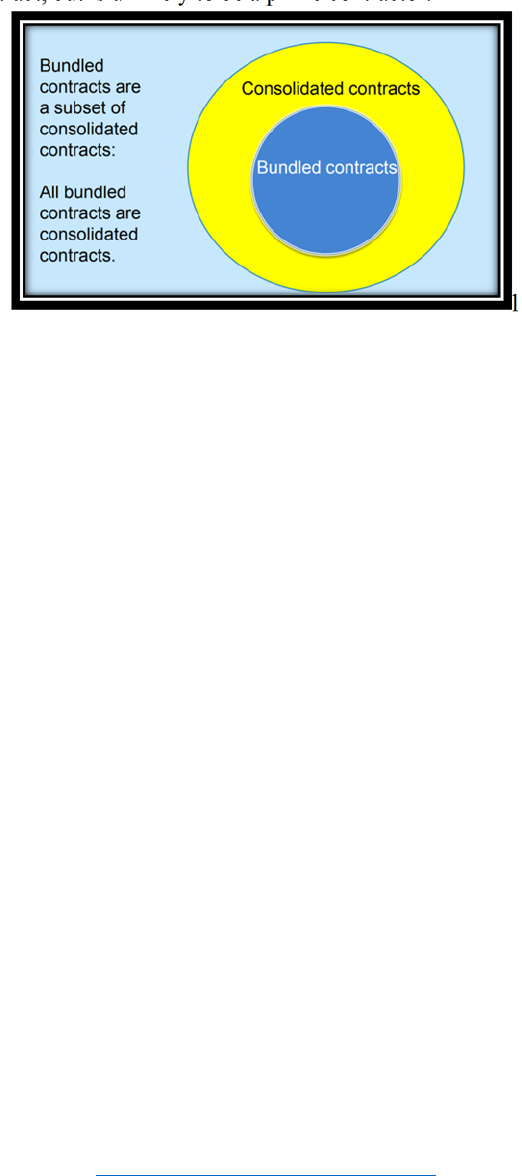
MAY 2018 | VERSION 3.0 | available at http://business.defense.gov/Acquisition/Policy/
(3) This definition does not apply to a contract that will be awarded and performed entirely outside
of the United States.
To reiterate, bundling is a specific type of consolidation that results in a requirement that is likely
to be unsuitable for award to a small business as a prime contractor. A small business can
participate in the contract, but is unlikely to be a prime contractor.
l
Substantial bundling, defined in FAR 7.107-4, is any bundling that results in a contract or order
with an estimated value of $8 million or more for the DoD. This threshold applies to the
cumulative estimated dollar value of multiple award contracts, task or delivery orders issued
against a GSA Schedule contract, or task or delivery orders issued against a task-order or
delivery-order contract awarded by another agency.
In addition to addressing the requirements for bundling, when the proposed acquisition strategy
involves substantial bundling, the agency shall document:
(1) The specific benefits anticipated to be derived from substantial bundling;
(2) An assessment of the specific impediments to participation by small business concerns as
contractors that result from substantial bundling;
(3) Actions designed to maximize small business participation as contractors, including provisions
that encourage small business teaming;
(4) Actions designed to maximize small business participation as subcontractors (including
suppliers) at any tier under the contract, or order, that may be awarded to meet the requirements;
(5) The determination that the anticipated benefits of the proposed bundled contract or order
justify its use; and
(6) Alternative strategies that would reduce or minimize the scope of the bundling, and the
rationale for not choosing those alternatives.
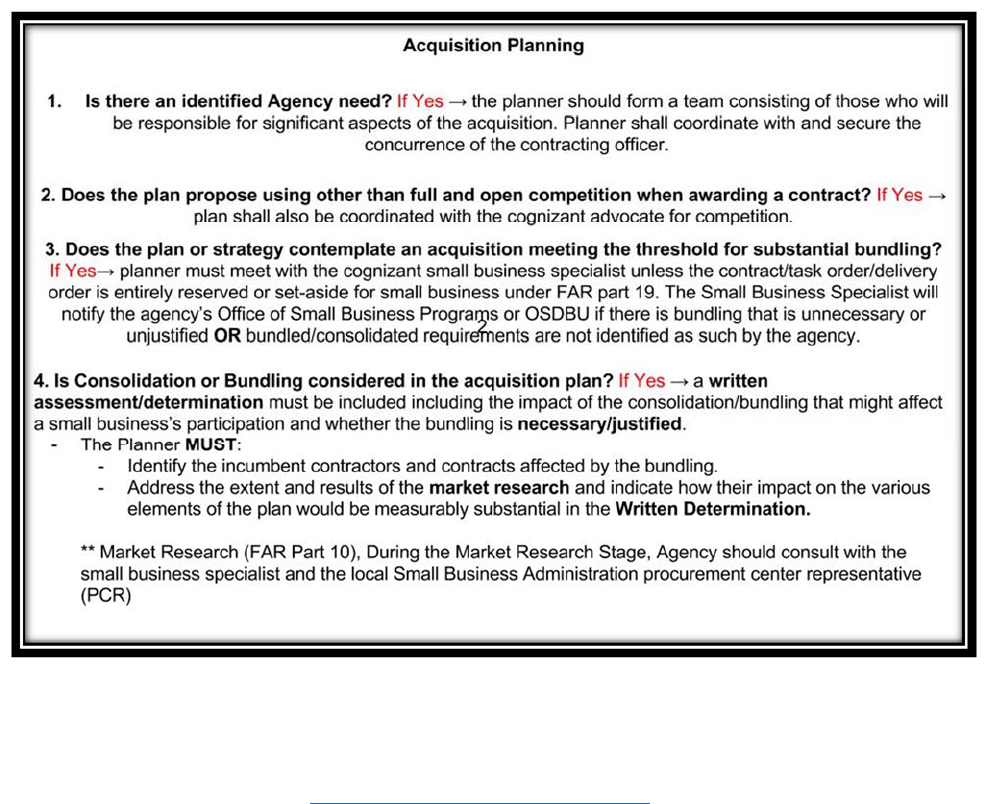
MAY 2018 | VERSION 3.0 | available at http://business.defense.gov/Acquisition/Policy/
SPECIAL NOTE FOR BUNDLING IN MULTIPLE-AWARD CONTRACTS
Consolidation and bundling in multiple award contracts presents special challenges, due to
Federal Procurement Data System, Next Generation (FPDS-NG) reporting limitations. For
example, consider a single solicitation for $300 million which resulted in five, multiple-award
contracts, each of which is subject to the aggregate ceiling value of $300 million of the entire
requirement.
A search of FPDS-NG for bundled contract actions will return each multiple-award contract as a
separate, $300 million bundled requirement. It is incorrect to interpret these five, multiple-award
contracts as $1.5 billion in bundled requirements ($300 million multiplied by five). The five
multiple-award contracts represent the same bundled requirement, which has an aggregate
ceiling value of $300 million. Therefore, the total dollar value of bundled contract requirements
is $300 million, not $1.5 billion.
ACQUISITION PLANNING
FAR Part 7 contains guidance for acquisition planning:

MAY 2018 | VERSION 3.0 | available at http://business.defense.gov/Acquisition/Policy/
“Acquisition planning should begin as soon as the agency need is identified, preferably well in
advance of the fiscal year in which contract award or order placement is necessary. In developing
the plan, the planner shall form a team consisting of all those who will be responsible for
significant aspects of the acquisition, such as contracting, small business, fiscal, legal, and
technical personnel.”
2
“The planner shall coordinate with and secure the concurrence of the contracting officer in all
acquisition planning. If the plan proposes using other than full and open competition when
awarding a contract, the plan shall also be coordinated with the cognizant advocate for
competition.”
3
FAR 7.104(d) directly involves the DoD small business professional (SBP) in the acquisition
planning:
“The planner shall coordinate the acquisition plan or strategy with the cognizant small business
specialist when the strategy contemplates an acquisition meeting the thresholds in 7.107-4 for
substantial bundling unless the contract or task order or delivery order is entirely reserved or set-
aside for small business under Part 19. The small business specialist shall notify the agency Office
of Small and Disadvantaged Business Utilization or the Office of Small Business Programs if the
strategy involves:
(1) Bundling that is unnecessary or unjustified; or
(2) Bundled or consolidated requirements not identified as such by the agency (see FAR
7.107)”
When writing the acquisition plan, pursuant to FAR 7.105, if consolidation or bundling are
considered, a written assessment must be included that considers the impact of the consolidation
or bundling that might affect a small business’s participation. It is the responsibility of the
planner that “when the proposed acquisition strategy involves bundling, [the planner must]
identify the incumbent contractors and contracts affected by the bundling.”
4
The written
acquisition plans must also “address the extent and results of the market research and indicate
their impact on the various elements of the plan (see [FAR] part 10).”
5
The acquisition planner must conduct a cost-benefit analysis of the possible impact of bundling
on small businesses. There are substantial benefits that can be provided to the Government from
bundling, but these benefits must be demonstrated before bundling can be considered necessary
and justified.
6
The impact on small businesses must be analyzed, assessed, and compared to the
substantial benefits to the Government within the cost-benefit analysis documentation. Before
2
FAR 7.104(a)
3
FAR 7.104(c)
4
FAR 7.105(b)(1)(iv)
5
FAR 7.105(b)(1)(v).
6
FAR 7.107-3(a)

MAY 2018 | VERSION 3.0 | available at http://business.defense.gov/Acquisition/Policy/
conducting an acquisition that involves bundling, a written determination needs to be drafted that
deems the bundling to be “necessary and justified.”
Bundling is “necessary and justified” where the agency would obtain “measurably substantial
benefits as compared to meeting its agency’s requirements through separate smaller contracts or
orders.”
7
The written determination needs to “quantify the specific benefits identified through the use of
market research and other techniques to explain how their impact would be measurably
substantial (see [FAR] 10.001(a)(2)(iv) and 10.001(a)(3)(vii)).”
8
According to FAR 7.107-3:
“Such benefits may include, but are not limited to--
1. Cost savings;
2. Price reduction;
3. Quality improvements that will save time or improve or enhance performance or
efficiency;
4. Reduction in acquisition cycle times; or
5. Better terms and conditions.”
9
The benefits are considered “measurably substantial” if
“individually, in combination, or in the aggregate the anticipated financial benefits are equivalent
to--
1. Ten percent of the estimated contract or order value (including options) if the value is
$94 million or less; or
2. Five percent of the estimated contract or order value (including options) or $9.4 million,
whichever is greater, if the value exceeds $94 million.”
10
Although a decrease in administrative or personnel costs can be one consideration when
determining whether bundling is justified, it is not a sufficient justification for bundling unless
“the cost savings are expected to be at least ten percent of the estimated contract or order value
(including options) of the bundled requirements.”
11
The benefits of cost savings and price reduction are evaluated by the agency and the SBA by
comparing the price of the work previously performed by the small business concerns. If
previous prices charged are unavailable, an estimated price (established by market research) that
7
FAR 7.107-3(a) and (b)
8
FAR 7.107-3(b)
9
FAR 7.107-3(c)
10
FAR 7.107-3(d)
11
FAR 7.107-3(e)
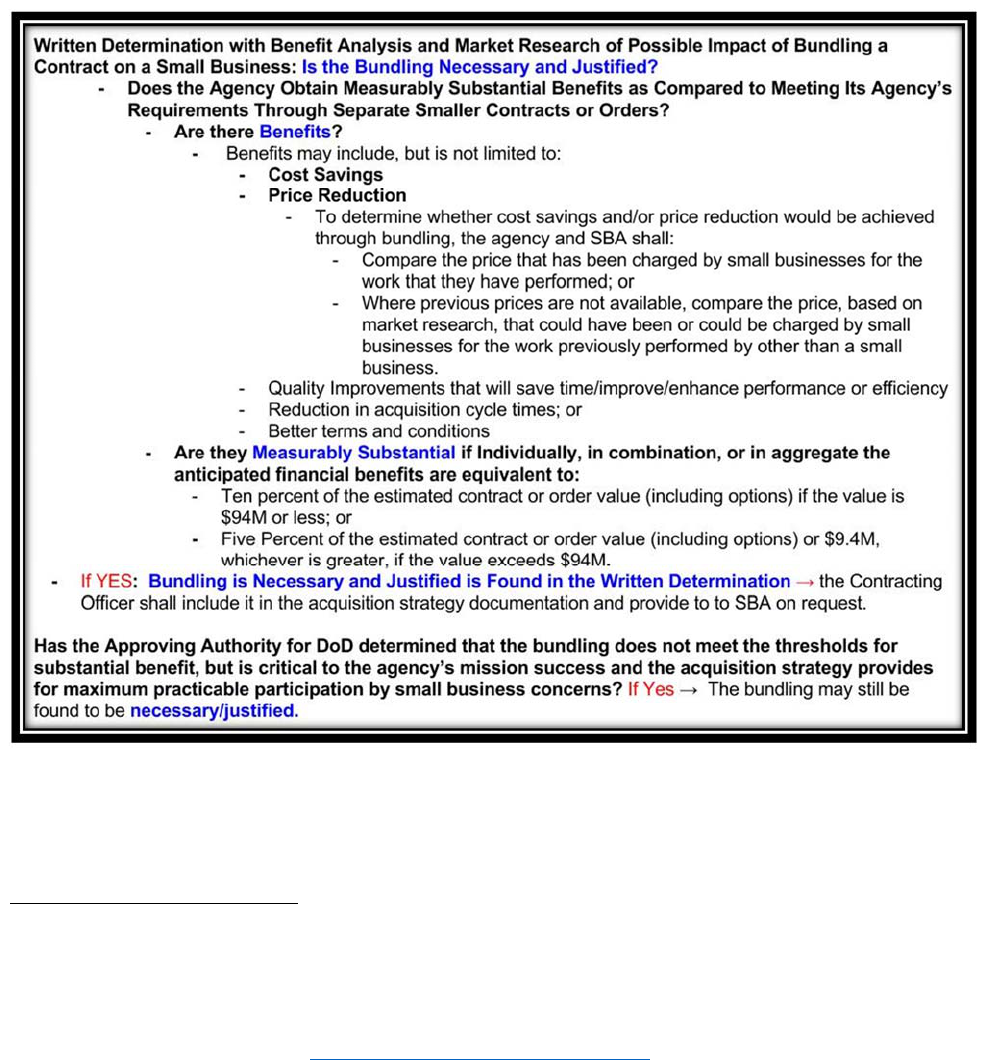
MAY 2018 | VERSION 3.0 | available at http://business.defense.gov/Acquisition/Policy/
could have been or could be charged by a small business can be compared to prices for work
previously performed by other than small businesses.
12
The role of market research (see FAR Part 10 for further details) is to aid in the benefit
analysis for any agency considering consolidation or bundling. During the market research stage,
the agency should consult with SBP and the local SBA procurement center representative
(PCR).
13
Additionally, the agency is required to notify the incumbent small business concerns
who may be affected by the Government’s intention to bundle and provide the contact
information for the local SBA PCR for further details.
14
12
FAR 7.107-3(g)
13
FAR 10.001(c)(1)
14
FAR 10.001(c)(2)
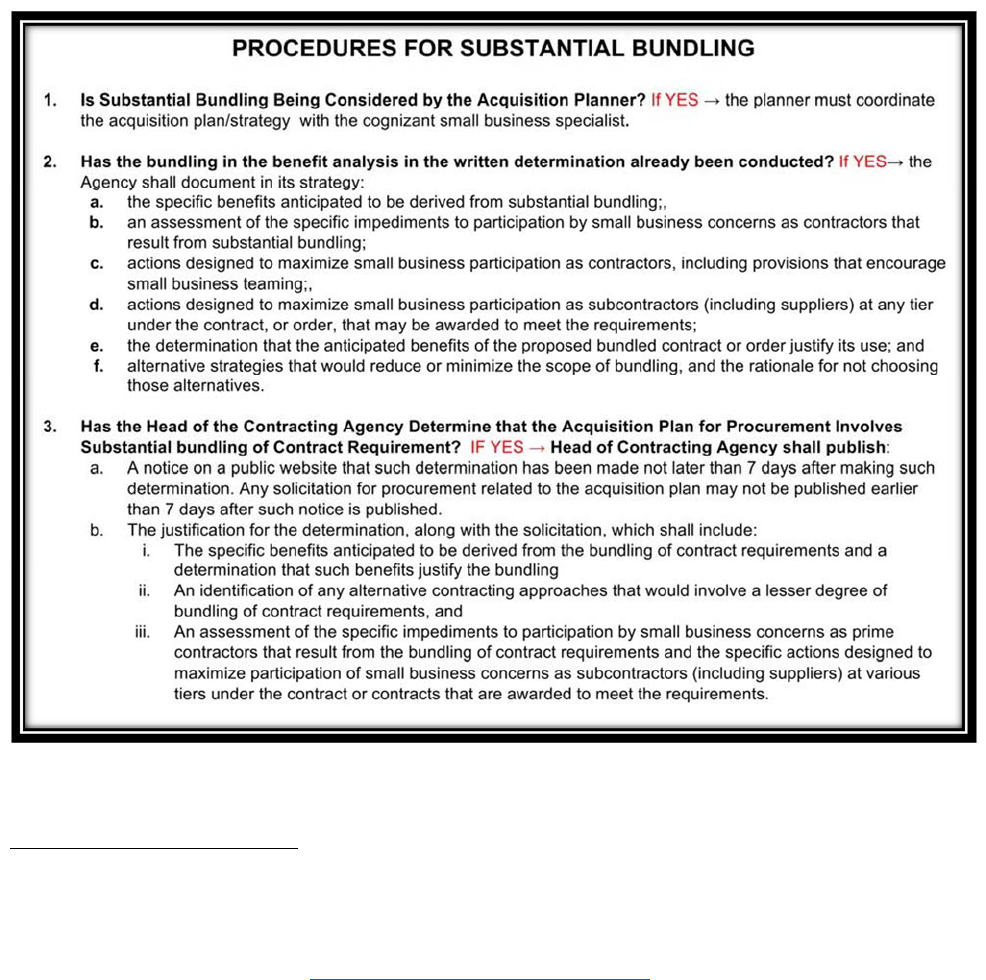
MAY 2018 | VERSION 3.0 | available at http://business.defense.gov/Acquisition/Policy/
Where substantial bundling is being considered,
15
according to 15 USC 644(e)(3) and FAR
7.107-4, the agency must also document within in its acquisition strategy and publish a notice on
a public website the following analysis:
“the specific benefits anticipated to be derived from substantial bundling, an assessment of the
specific impediments to participation by small business concerns as contractors that result from
substantial bundling, actions designed to maximize small business participation as contractors,
including provisions that encourage small business teaming, actions designed to maximize small
business participation as subcontractors (including suppliers) at any tier under the contract, or
order, that may be awarded to meet the requirements; the determination that the anticipated
benefits of the proposed bundled contract or order justify its use, and alternative strategies that
would reduce or minimize the scope of the bundling, and the rationale for not choosing those
alternatives.”
16
15
For the Department of Defense, the threshold for substantial bundling is $8 million. FAR 7.107-4(a)(1)(i).
16
15 USC 644(e)(3)

MAY 2018 | VERSION 3.0 | available at http://business.defense.gov/Acquisition/Policy/
The approving authority for DoD, without power of delegation, is the senior procurement
executive (SPE).
17
When considering bundling, the SPE “...may determine that bundling is
necessary and justified when the expected benefits do not meet the thresholds for a substantial
benefit but are critical to the agency’s mission success and the acquisition strategy provides for
maximum practicable participation by small business concerns.”
18
If the bundling is determined
to be necessary and justified, the contracting officer shall include it in the acquisition strategy
documentation and provide it to SBA upon request.
19
POST-DETERMINATION NOTIFICATIONS
20
Once the cost-benefit analysis determination is complete and included in the acquisition strategy,
the agency must notify several different parties of its intent to bundle the requirement. These
notifications include:
1. Notifications made to current small business contractors
2. Notification to the public of rationale for bundled requirement
3. Notification to SBA of followed-on bundled or consolidated requirements
4. Notification to the public of the agency’s general bundling policy
5. Notification of substantial bundling
Notifications made to current small business contractors
21
“The contracting officer shall notify each small business performing a contract that it intends to
bundle the requirement at least 30 days prior to the issuance of the solicitation for the bundled
requirement.”
The notification must have the following:
● Name,
● Phone number, and
17
FAR 7.107-3(f)(2)
18
FAR 7.107-3(f)(1)(i) and (ii).
19
FAR 7.107-3(h)
20
FAR 7.107-5
21
FAR 7.107-5(a)

MAY 2018 | VERSION 3.0 | available at http://business.defense.gov/Acquisition/Policy/
● Address of the applicable SBA procurement center representative (PCR).
22
Notification to public of rationale for bundled requirement
23
“The agency shall publish on its website a list and rationale for any bundled requirement for
which the agency solicited offers or issued an award. The notification shall be made within 30
days of the agency’s data certification regarding the validity and verification of data entered in
the Federal Procurement Data System to the Office of Federal Procurement policy.” (see FAR
4.604).
24
The agency is encouraged to provide notification of the rationale for any bundled requirement to
the GPE, before issuance of the solicitation (see FAR 5.201).
Notification to SBA of follow-on bundled or consolidated requirements
25
“For each follow-on bundled or consolidated requirement, the contracting officer shall the
following from the requiring activity and notify the SBA PCR no later than 30 days prior to the
issuance of the solicitation:
1. The amount of savings and benefits achieved under the prior consolidation or bundling;
2. Whether such savings and benefits will continue to be realized if the contract remains
consolidated or bundled
3. Whether such savings and benefits would be greater if the procurement requirements
were divided into separate solicitations suitable for aware to small business concerns.
4. List of requirements that have been added or deleted for the follow-on.”
Public Notification of bundling policy
26
“In accordance with 15 USC 644(q)(2)(A)(ii), agencies shall publish the Government wide
policy regarding contract bundling, including regarding the solicitation of teaming and joint
ventures, on their agency website.”
22
“If an SBA PCR is not assigned to the procuring activity, the SBA Office of Government Contracting Area Office
serving the area in which the buying activity is located...The notification shall be documented in the contract file.”
FAR 7.107-5(a)(2)
23
FAR 7.107-5(b)
24
15 USC Sec 644(q)(2)(B)
25
FAR 7.107-5(c)
26
FAR 7.107-5(d)
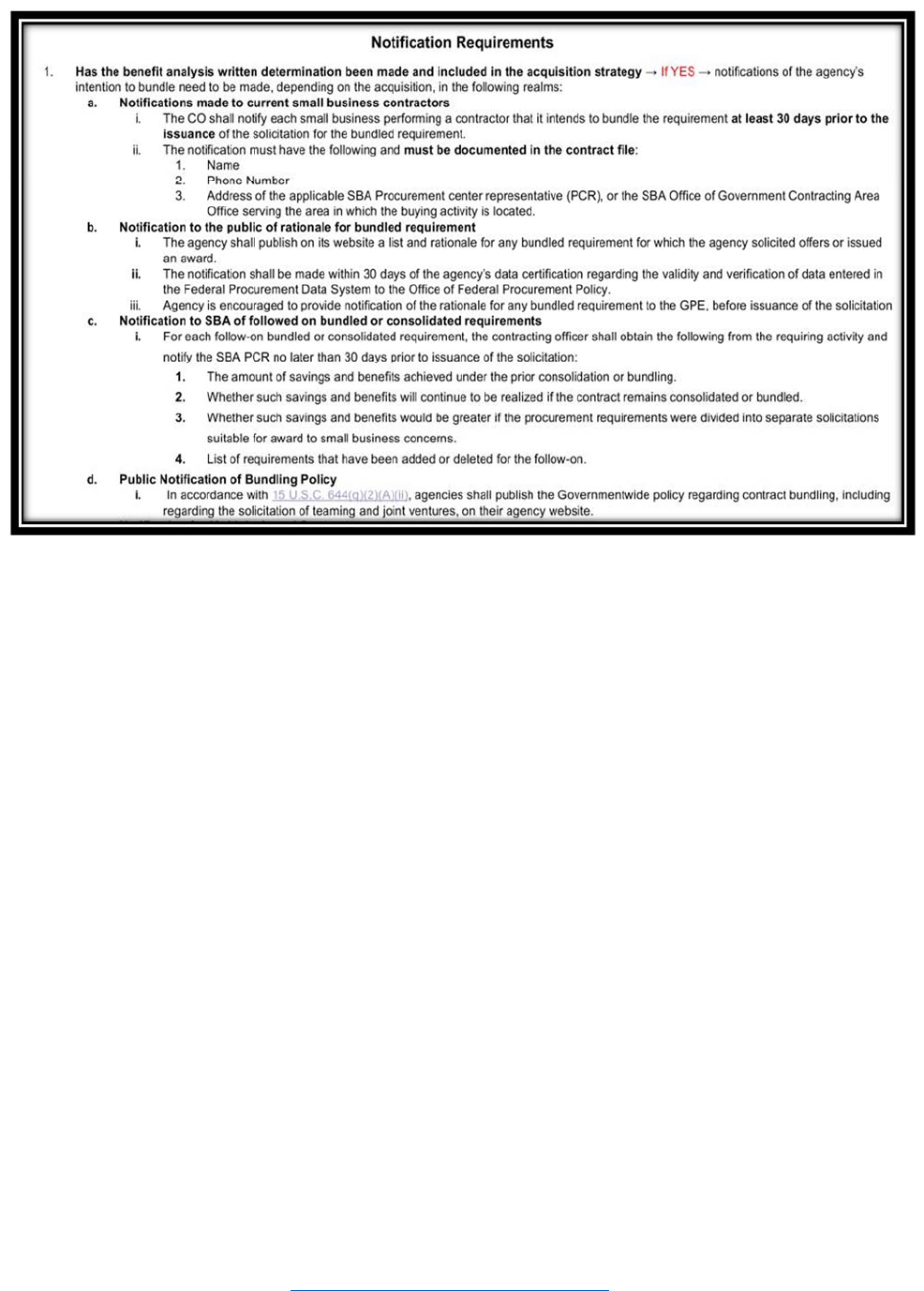
MAY 2018 | VERSION 3.0 | available at http://business.defense.gov/Acquisition/Policy/
Notification for Substantial Bundling
If the head of a contracting agency determines that an acquisition plan for a procurement
involves a substantial bundling of contract requirements, the head of a contracting agency shall
publish a notice on a public website that such determination has been made not later than 7 days
after making such determination.
Any solicitation for a procurement related to the acquisition plan may not be published earlier
than 7 days after such notice is published. Along with the publication of the solicitation, the head
of a contracting agency shall publish a justification for the determination, which shall include the
information found in 15 USC 644(e)(3) and FAR 7.107-4.
SBA ANNUAL REPORTING
15 USC Sec 644(p)(4)(B) requires that the SBA submit an annual report on contract bundling to
the House and Senate Committees on Small Business describing:
“(i) data on the number, arranged by industrial classification, of small business concerns displaced
as prime contractors as a result of the award of bundled contracts by Federal agencies; and

MAY 2018 | VERSION 3.0 | available at http://business.defense.gov/Acquisition/Policy/
(ii) a description of the activities with respect to previously bundled contracts of each Federal
agency during the preceding year, including—
(I) data on the number and total dollar amount of all contract requirements that were
bundled; and
(II) with respect to each bundled contract, data or information on—
(aa) the justification for the bundling of contract requirements;
(bb) the cost savings realized by bundling the contract requirements over the life
of the contract;
(cc) the extent to which maintaining the bundled status of contract requirements
is projected to result in continued cost savings;
(dd) the extent to which the bundling of contract requirements complied with the
contracting agency’s small business subcontracting plan, including the total dollar value
awarded to small business concerns as subcontractors and the total dollar value
previously awarded to small business concerns as prime contractors; and
(ee) the impact of the bundling of contract requirements on small business
concerns unable to compete as prime contractors for the consolidated requirements and
on the industries of such small business concerns, including a description of any changes
to the proportion of any such industry that is composed of small business concerns.”
